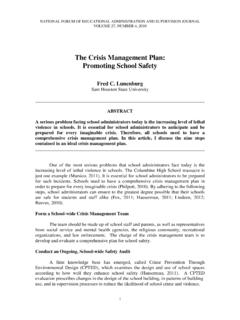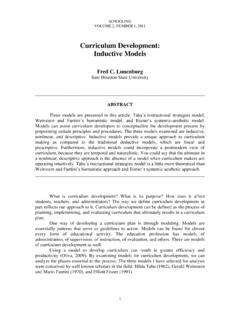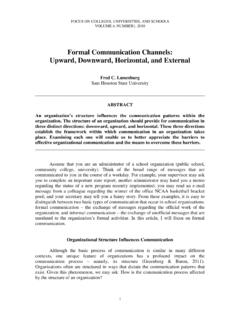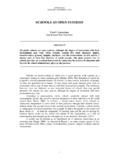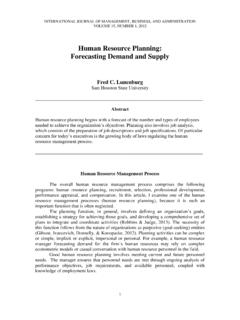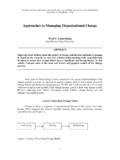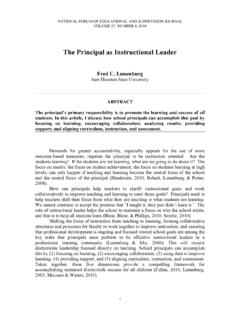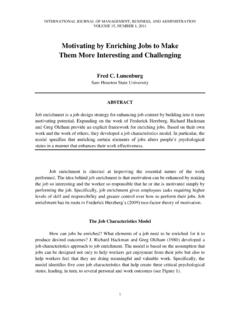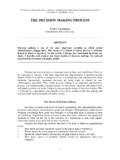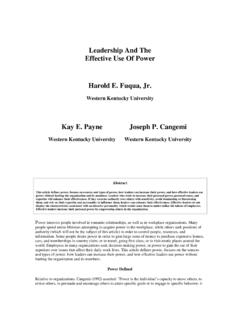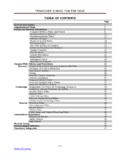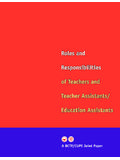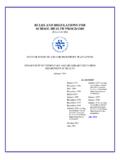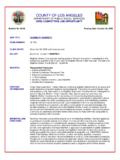Transcription of The Principal and the School: What Do Principals Do?
1 NATIONAL FORUM OF EDUCATIONAL ADMINISTRATION AND SUPERVISION JOURNAL. VOLUME 27, NUMBER 4, 2010. The Principal and the school : what Do Principals Do? Fred C. Lunenburg Sam Houston State University _____. ABSTRACT. Although functions vary by locality and school size, the Principal is primarily responsible for administering all aspects of a school 's operations. In this article, I. discuss what Principal 's actually do on a day-to-day basis. I examine the Principal 's job from the following perspectives: leadership functions, administrative roles, management skills, task dimensions, human resource activities, and behavioral profiles of effective versus successful administrators.
2 _____. Typically, each school has a single administrative officer, a Principal , who is responsible for the operation of the school . In very small schools, the person may teach part-time as well. In large schools, there may be one or more assistant Principals . The administrative hierarchy may consist also of a number of department chairpersons, school counselors, a social worker, school psychologist, diagnostician, and so on. Although functions vary by location and size, the Principal is primarily responsible for administering all aspects of a school 's operations. what then do Principals actually do on a day-to-day basis?
3 One way to analyze what Principals do is to examine their job from a number of perspectives: (a) leadership functions, (b) administrative roles, (c) management skills, (d) task dimensions, (e) human resource activities, and (f). behavioral profiles of effective versus successful administrators. Each one will be discussed in turn. Leadership Functions Principals combine and coordinate various kinds of resources by carrying out four basic leadership functions: planning, organizing, leading, and monitoring. The relationships among these functions are shown in Figure 1. NATIONAL FORUM OF EDUCATIONAL ADMINISTRATION AND SUPERVISION JOURNAL.
4 2_____. 1. Planning 4. Monitoring 2. Organizing 3. Leading Figure 1. Four functions of administration. Planning Generally, planning defines where the school wants to be in the future and how to get there (Parker, 2011). Plans and the goals on which they are based give purpose and direction to the school , its subunits, and contributing staff. For example, suppose the Principal in a large, urban school district decides that the school should attempt to increase the number of students reading at grade level by 20 percent by the year 2012. This goal and the methods needed to attain it would then serve as the planning framework for the school (Gardiner, 2011).
5 school counselors, social workers, school psychologists, library media specialists, department heads, and teachers would set and synchronize individual objectives with those of the building Principal . Planning is important because it provides staff with a sense of purpose and direction, outlines the kinds of tasks they will be performing, and explains how their activities are related to the overall goals of the school (Oosterlynck, 2011). Without this information, staff would not know precisely how to use their time and energies efficiently and effectively. Subsequently, they would respond to their job responsibilities randomly, wasting valuable human resources.
6 Planning is also a prerequisite to other leadership functions (Goodstein, 2011). In particular, it becomes the basis for monitoring and evaluating actual performance (McDonnell, 2011). That is, plans made during the first step become benchmarks or criteria against which to measure actual performance in the monitoring step. Unless plans are formulated and mutually agreed on, there is relatively little value or basis for measuring the effectiveness of the school outcomes (Lunenburg & Irby, 2006; Lunenburg & Ornstein, 2008). In addition, comparing planned and actual results provides the Principal with a sound basis on which to make necessary adjustments in the school 's plan of action.
7 FRED C. LUNENBURG. _____3. Since the 1970s, criticisms of traditional planning models have resulted in the development of the strategic planning approach (Boschee, 2009). New ideas have arisen about the nature of educational organizations. Schools have been described as loosely- coupled systems (Meyer & Rowan, 1977; Rowan, 1990; Weick, 1976) and organized anarchies (Cohen, March, & Olsen, 1972). The challenges facing schools have changed significantly as new demands have been placed on them. Their environment has become uncertain and even hostile. Strategic planning, a subset of the public policy process, could be an ideal technology for shaping the future of education (Boschee, 2009).
8 Given the contextual constraints on educational policy (social, economic, and political), the challenge for educational strategic planners is to understand the internal and external boundaries and to use this understanding to design policies that could facilitate change in student achievement and the very structure of schools (Marzano & Waters, 2010). Organizing Once Principals have developed workable plans and the methods for attaining them, they must design an organization that will successfully implement the plans. Organizing involves three essential elements (Argyris, 2011): developing the structure of the organization, acquiring and developing human resources, and establishing common patterns and networks.
9 In a very basic sense, designing the structure of the organization involves creating the organizational chart for a school (Jones, 2010). The Principal establishes policies and procedures for authority relationships, reporting patterns, the chain of command, departmentalization, and various administrative and subordinate responsibilities. Then the Principal takes steps to hire competent personnel. When necessary, the Principal establishes programs for training new personnel in the skills necessary to carry out their task assignments. Finally, the Principal builds formal communication and information networks, including the types of information to be communicated, direction of communication flows, and reductions in barriers to effective communication.
10 Organizing at the upper levels of an organization usually includes designing the overall framework for the school district (Grant, 2011). At the building level, however, organizing is usually more specific and may involve the following specific activities (Burton, 2007): developing methods to help people understand what portion of the job is their responsibility; coordinating individual efforts through work schedules to avoid unnecessary delay in task accomplishment; designing an efficient system for making day- to-day work assignments should these be necessary; and cross-training personnel or providing for substitute personnel to avoid disruptions in the flow of work caused by absenteeism.
